Research held by Induction Switch reveals the average switchboard wait time plus the number of calls being made per day.
Traditional methods of clinical communication within the NHS are outdated and time consuming. On average, clinicians sending a bleep could be waiting up to 9.35 minutes for a reply, representing significant inefficiency in time management.
Sponsored by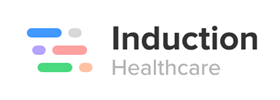
Induction Switch have conducted a study in nine major UK hospitals and Trusts by logging the average switchboard wait time plus the number of calls being made per day. Learn more on how Induction Switch has saved hospital-based junior doctors hours of time per week as well as annual cost savings of over £100,000 per hospital.
Overview
Clinicians within the NHS Trusts at all levels, work in a very stretched system and face significant workloads. While the majority of healthcare professionals have smartphones in their pockets, communication between colleagues and clinical teams still very frequently involves either the switchboard, pagers or a fax machine. We are surrounded by ubiquitous technology choices and have the ability to instantly contact anyone, anytime, anywhere. However, these archaic approaches within the NHS are ever present and remind us of how far we still need to go in order to advance communication and help streamline delivery of patient care.
“I can’t bear to think how many hours I’ve wasted over these 12 months of being a doctor, being on hold or making phone calls. With Switch, you’re not only saving junior doctors’ time, you’re saving money as well –plus if you have more doctor time available, then it benefits things like patient safety. It has ramifications beyond the ease of just looking something up on your phone.”
Ed Appleby, Junior Doctor – Warrington Hospital
Challenge
A significant proportion of a doctor’s time is taken up by performing drawn out administrative tasks. For example, getting through to the operator or waiting for an available phone to return any incoming bleeps. These traditional ways in which staff communicate with each other are both outdated and laborious.
Each step in these processes is unproductive and a waste of crucial time in a hospital environment. Whether it is walking to find an available phone, queuing to use this phone, listening to a pre-recorded message; waiting for the operator to answer and then finally, being connected to the correct extension.
A recent study featured in the Future Health Journal found that a total of 1,632 bleeps were received by eight medical on-call doctors covering the medical wards at a major south England Hospital. This was over eight weekend periods, consecutively. The bleep log revealed that 92% of bleeps interrupted a task and 14% of bleeps were directed to incorrect doctors, causing even more interruption and time spent on redirection.
Clinicians sending a bleep could be waiting an average of 9.35 minutes for a reply, representing significant inefficiency in time management. Assuming five minutes spent answering each bleep, an on-call doctor spends an average of three hours (range 1.4–4.5) in every 24-hour period answering bleeps. For the bleep sender, this equates to an average of 5.7 hours in a 24-hour period waiting for a call back.
Solution
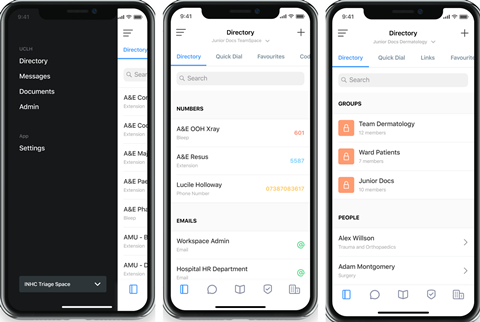
Induction Switch app was launched in 2014. Currently with over 140,000 users, and the majority of junior doctors using it, this makes Induction Switch the most used app by doctors within the NHS.
As of December 2020, on average the Induction Switch directory is accessed 1.25 times per second with calls being made off the app once ever 7.5 seconds. This study was conducted to identify the real time and cost savings to both doctors and hospital trusts that can be achieved through using Induction Switch.
The primary feature within Induction Switch is its comprehensive directory. This functionality combines a crowd sourced hospital directory, the ability to “quick dial” directly from the app plus identify incoming bleeps. This functionality completely negates the need for a hospital phone or switchboard.
In order to display how much time a hospital-based doctor can save per week by using the Induction Switch app and to estimate potential cost savings per annum, we conducted a recent study in nine major UK hospitals. Over a five-day period, our users sought out to record how many directory views, quick dials and guideline views were conducted using Switch amongst nine major hospitals.
Timelines
Fifty-four doctors spread across nine hospitals and Trusts in the UK participated. These clinicians logged the average switch board wait times (from the moment call was made to operator until put through to correct extension) and how many calls/bleeps they made per day over five days. Induction Switch data was extracted from our analytics platform to determine its use in these hospitals over the same time period.
- Data collection of 54 doctors to determine how many calls/bleeps are made per day per doctor over a five-day period (Monday to Friday)
- These doctors recorded and subsequently were able to determine the average wait time for switchboard across 10 time points by 54 doctors at a sample of nine hospitals. Additionally, determine how many directory views, quick dials and guidelines are viewed via Induction Switch per week at each of these hospitals.
- Determine the total time spent making phone calls, quick dials or locating guidelines both before and after the implementation of Induction Switch to establish both time and cost savings after Induction Switch adoption.
Results
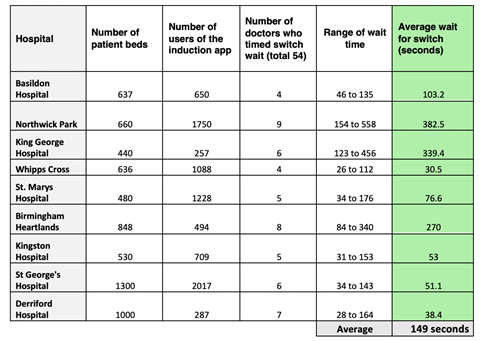

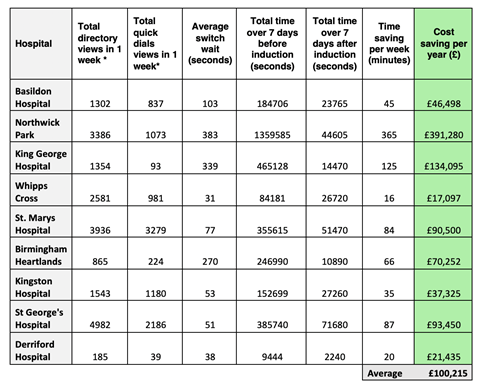
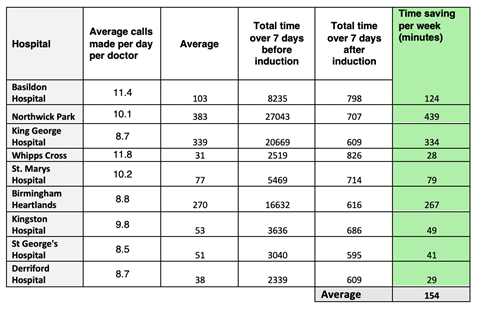
- The average switchboard wait across all hospitals was 149 seconds (±140.5 SD, range 53- 382 seconds) (Table 1).
- 54 doctors making an average of 8.5-11.4 bleeps/calls a day, which averages 9.8 calls/bleeps a day, this is likely to be higher when doctors are on call. (Table 2).
- The average annual cost saving in a year, by using the Induction app rather than traditional methods was estimated to be £100,215 (Table 3).
- Doctors are estimated to save an average of 154 minutes (2.5 hours) per week through using the Induction app (Table 4).
This research estimates an average cost saving per hospital per year of £100,251. If we take our collected data and look at this from an NHS regional perspective; we can see the potential following cost and time savings:
Example:
Total no. of Acute Trusts in the London Region = 39
Average annual cost saving per Hospital = £100,251
Average annual region al cost savings = £100,251 x 39 = £3,909,789
Benefits
Despite the potential benefits of technology, it is generally acknowledged that its adoption within the NHS is slow and disparate. The Healthcare Industries Task Force, for example, described the National Health Service as “a late and slow adopter of technology” (Healthcare Industries Task Force 2004).
To help alter out view on such technologies, Switch was created appropriately to ensure ease of use for maximum uptake by healthcare professionals. This helped to improve the efficiency of communication and time management within Trusts and this study highlights just that.
With the implementation of Induction Switch trust wide we can see there is a variety of benefits across staff, management and patient levels. Induction Switch as a utility can save doctors a significant amount of time, improve efficiency and as illustrated, can have significant financial benefits on a hospital trusts and regional level.
In addition to the cost saving benefits for trusts within the NHS, these have an added impact on other areas within the Trust operations. Time spent by Trust staff on tasks which are unrelated to patient care, e.g. waiting for a computer to load or being on hold on a telephone call is therefore time when patient care cannot be delivered.
Induction Switch is giving back time to our users. As the NHS and its workers prepare to restart after the heavy impact of the COVID-19 pandemic, we believe that Induction Switch is well equipped and prepared to support our users streamline their delivery of care by availing of efficient digital solutions.
Further readings:
1. Sin FE, Watts G, Kingdon E. The effects of bleeps on medical on-call doctors’ workflow and work efficiency. Future Healthc J. 62019. p. 77.
2. Time-Saving Solution for the Emergency Medicine | QUALITANCE. 2020.
3. R M, C R. Time-motion analysis examining of the impact of Medic Bleep, an instant messaging platform, versus the traditional pager: a prospective pilot study. Digital health. 2019;5.
4. J H, W B, J C, E M. Sharing knowledge, saving time: an online toolbox to aid junior doctors. BMJ quality improvement reports. 2014;2(2).
5. Davies M, Panchal S. MediDial cards: a quick win for service improvement. BMJ Qual Improv Rep. 32014.


























